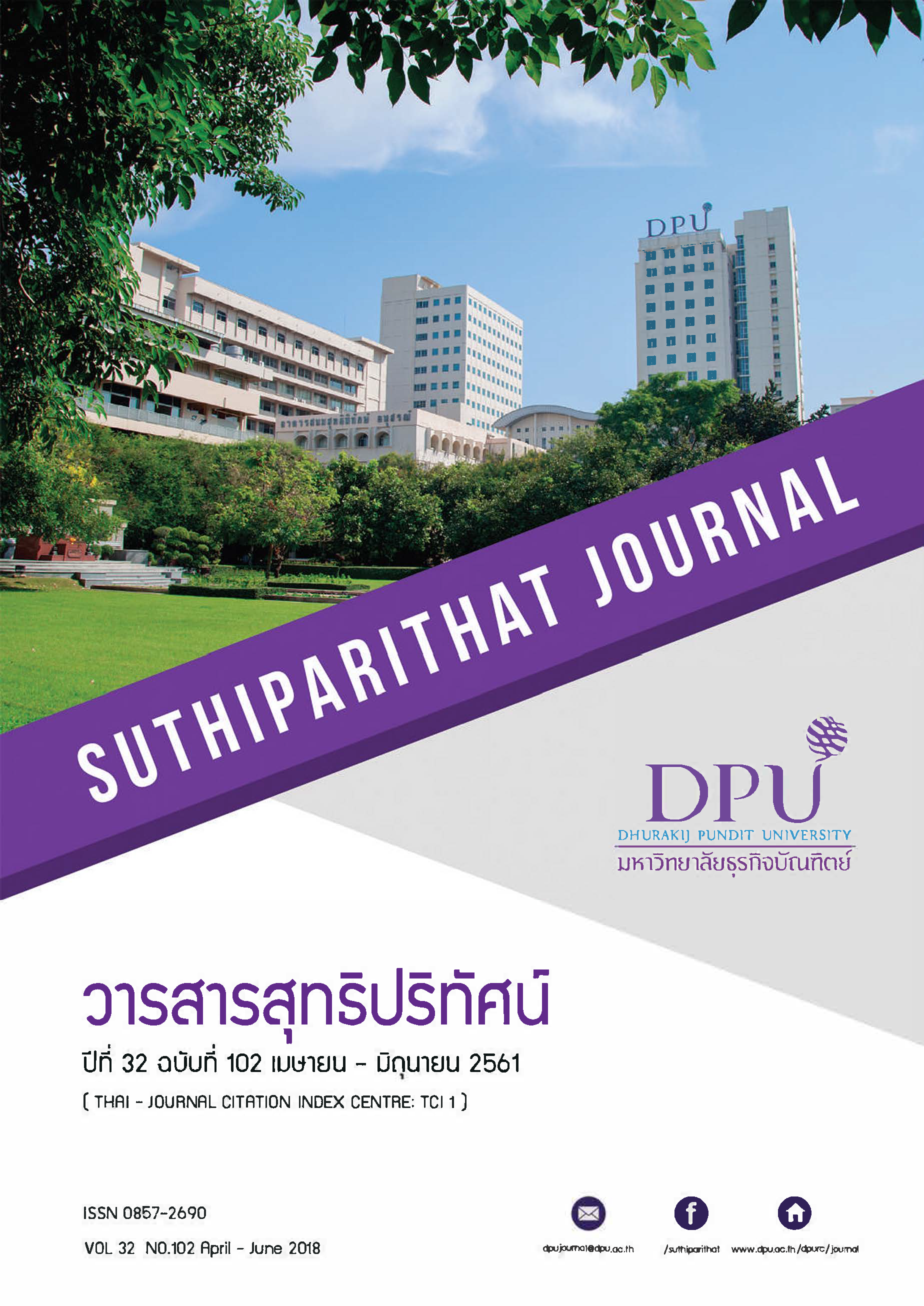แบบจำลองการประมาณประสิทธิภาพของหลักทรัพย์ในตลาดหลักทรัพย์แห่งประเทศไทยด้วยการวิเคราะห์การถดถอยโลจิสติกส์
คำสำคัญ:
ประสิทธิภาพของหลักทรัพย์, กำไรส่วนเกินทุน, อัตราส่วนทางการเงิน, การถดถอยโลจิสติกส์และมูลค่าทางการตลาดบทคัดย่อ
นักลงทุนทั่วไปควรมีความสามารถในการระบุปัจจัยหลักที่มีอิทธิพลต่อประสิทธิภาพของหลัก ทรัพย์เพื่อใช้ในการตัดสินใจลงทุนด้วยวิธีการไม่ซับซ้อนและได้ผลลัพธ์ที่แม่นยำ การวิจัยครั้งนี้จึงมี วัตถุประสงค์เพื่อหาแบบจำลองทางการเงินเพื่อประมาณการหลักทรัพย์ที่มีประสิทธิภาพภายใต้สภาพ แวดล้อมที่เปลี่ยนแปลงของบริษัทหลักทรัพย์ที่จดทะเบียนในตลาดหลักทรัพย์แห่งประเทศไทย โดยใช้ ข้อมูลทางการเงินใน พ.ศ. 2559-2560 จำนวน 668 หลักทรัพย์ ด้วยการวิเคราะห์การถดถอยโลจิสติกส์ (Logistic Regression Analysis: LRA) ผลการวิจัยพบว่า การกำหนดเกณฑ์ประสิทธิภาพที่ได้จากกำไร ส่วนเกินทุน (Capital Gain Yield) เทียบกับค่าเบต้า(Beta) ทั้ง 4 แบบจำลองตามสถานการณ์ ล้วนทำนาย หลักทรัพย์ที่มีประสิทธิภาพได้อย่างแม่นยำตั้งแต่ 91.5-98.7% โดยแบบจำลองในสถานการณ์ที่ 1 มี ความแม่นยำสูงที่สุด ทั้ง 4 แบบจำลองได้รับอิทธิพลทางตรงเชิงบวกจากมูลค่าการซื้อขายสูงที่สุด ใน ทางกลับกันได้รับอิทธิพลเชิงลบจากมูลค่าทางการตลาด รองลงมาคืออัตราผลตอบแทนจากสินทรัพย์และ อัตราการถือครองหลักทรัพย์จากนักลงทุนรายย่อยอย่างมีนัยสำคัญ ณ ระดับ 0.10
เอกสารอ้างอิง
อาภากร วนเศรษฐ. (2559). ผลกระทบอัตราส่วนทางการเงินต่อราคาหลักทรัพย์ที่จดทะเบียนในตลาดหลักทรัพย์: กรณีประเทศไทยและอินโดนีเซีย. (การค้นคว้าอิสระ สาขาวิชาการบริหารการเงิน คณะพาณิชยศาสตร์และการบัญชี). กรุงเทพฯ: มหาวิทยาลัยธรรมศาสตร์.
ตลาดหลักทรัพย์แห่งประเทศไทย. [เว็บไซต์]. สืบค้นเมื่อ ตุลาคม 2560. สืบค้นจาก https://www.set.or.th/.
Arabsalehi, M., & Mahmoodi, I. (2012). The Quest for the Superior Financial Performance Measures. International Journal of Economics and Finance, 4(2). doi:10.5539/ijef.v4n2p116
Baba, N., & Kozaki, M. (n.d.). An intelligent forecasting system of stock price using neural networks. [Proceedings 1992] IJCNN International Joint Conference on Neural Networks. doi:10.1109/ijcnn.1992.287183
Ball, R., & Brown, P. (1968). An Empirical Evaluation of Accounting Income Numbers. Journal of Accounting Research, 6(2), 159.doi:10.2307/2490232
Basu, A. K., & O’Shea, L. (2014). The Predictive Ability of P/E Ratio: Evidence from Australia and New Zealand. SSRN Electronic Journal. doi:10.2139/ssrn.2376050
Chaieb, I., Errunza, V. R., & Gibson, R. (2016). How Does Sovereign Bond Market Integration Relate to Fundamentals and CDS Spreads? SSRN Electronic Journal. doi:10.2139/ssrn.2818266
Chan, L. K. C., Hamao, Y. and Lakonishok, J. Fundamentals and Stock Returns in Japan. Journal of Finance, 1991, vol. 46, issue 5, 1739-64
Chen, P., & Chen, W. (1986). Study on the distribution characteristics of Supplier in Chinese coals. Fuel, 65(9), 1305–1309. doi:10.1016/0016-2361(86)90246-2
Dodd, E. M., & Meyer, C. H. (1931). The Law of Stock Brokers and Stock Exchanges. Harvard Law Review, 44(7), 1168. doi:10.2307/1331377
Fama, E. F., Cochrane, J. H., Moskowitz, T. J., Cochrane, J. H., & Moskowitz, T. J. (2016). The Fama Portfolio. doi:10.7208/chicago/9780226426983.001.0001
Homa, K. E., & Jaffee, D. M. (1971). The Supply of Money and Common Stock Prices. The Journal of Finance, 26(5), 1045.doi:10.2307/2326082
Huang, D., & Miao, J. (2017). The Effect of Oil Price Changes on Stock Price Momentum. SSRN Electronic Journal. doi:10.2139/ssrn.2847514
Kendall, S. M., ord, K. (1990). Time Series. (3rd ed.). New York: Oxford University Press.
Landskroner, Y., & Ruthenberg, D. (2005). Diversification and Performance in Banking: The Israeli Case. SSRN Electronic Journal. doi:10.2139/ssrn.675230
Mironiuc, M., &Robu, M.-A. (2013). Obtaining a Practical Model for Estimating Stock Performance on an Emerging Market Using Logistic Regression Analysis. Procedia - Social and Behavioral Sciences, 81, 422–427. doi:10.1016/j.sbspro.2013.06.454
Mookerjee, R., & Yu, Q. (1997). Macroeconomic variables and stock prices in a small open economy: The case of Singapore. Pacific-Basin Finance Journal, 5(3), 377–388. doi:10.1016/s0927-538x(96)00029-7
Nelles, O. (2001). Fuzzy and Neuro-Fuzzy Models. Nonlinear System Identification, 299–340. doi:10.1007/978-3-662-04323-3_11
Oh, K.-Y., Kim, B., & Kim, H. (2006). An empirical study of the relation between stock price and EPS in panel data: Korea case. Applied Economics, 38(20), 2361–2369. doi:10.1080/00036840500427593
Petersen, G.-K., & Spickers, T. (2017). Investor Perception in Delegated Portfolio Management: How Manager Texts Influence Investor Behavior. SSRN Electronic Journal. doi:10.2139/ssrn.3033119
Pettengill, G. N., Chang, G., & Hueng, C. J. (2012). Identifying the Value Premium: A Test of Mutual Fund Performance Measures. SSRN Electronic Journal. doi:10.2139/ssrn.2139819
Qi, J. X., &Kan, Z. N. (2013). The Limitation of Free Float and Safety Float and the Introduction of Composite Free Float and Composite Safety Float in CPM Network. Advanced Materials Research, 860-863, 2962–2965. doi:10.4028/www.scientific.net/amr.860-863.2962
Rapee, P., Ke-Chung, P., & Kamonthip, M. (2017). The performance measurement of listed companies of the agribusiness sector on the stock exchange of Thailand. Agricultural Economics (Zemědělská Ekonomika), 63(No. 5), 234–245. doi:10.17221/291/2015-agricecon
Remorov, R. (2014). Stock Price and Trading Volume during Market Crashes. International Journal of Marketing Studies, 6(1). doi:10.5539/ijms.v6n1p21
Robu, M. A., & Robu, I. B. (2015). The Influence of the Audit Report on the Relevance of Accounting Information Reported by Listed Romanian Companies. Procedia Economics and Finance, 20, 562–570. doi:10.1016/s2212-5671(15)00109-4
Rosenberg, B., Reid, K., & Lanstein, R. (1985). Persuasive evidence of market inefficiency. The Journal of Portfolio Management, 11(3), 9–16. doi:10.3905/jpm.1985.409007
Rossi, S. B., Sloan, R. G., & Tracy, S. (2015). Forecasting Stock Price Crashes. SSRN Electronic Journal. doi:10.2139/ssrn.2585811
Schaik, L. van.(2008). Non-Fictional. doi:10.1007/978-3-7643-8201-8
Schwert, G. W. (1990). Stock Returns and Real Activity: A Century of Evidence. doi:10.3386/w3296
Shamsudin, N., Mahmood, W. M. W., & Ismail, F. (2013). The Performance of Stock and the Indicators. International Journal of Trade, Economics and Finance, 409–413. doi:10.7763/ijtef.2013.v4.327
Steinberger, J. (2017). Early life linear growth but not weight gain, impacts adult capital gain. The Journal of Pediatrics, 182, 4. doi:10.1016/j.jpeds.2017.01.009
Sun, L., & Lee, D. W. (2017). Factor Exposures of Foreign Equity Capital in a Domestic Stock Market: Evidence from Korea. International Review of Finance. doi:10.1111/irfi.12129
Ting, C. C. (2012). Market Value of the Firm, Market Value of Equity, Return Rate on Capital and the Optimal Capital Structure. International Journal of Financial Research, 3(4). doi:10.5430/ijfr.v3n4p1
Wagdi, O., Sherif, A., & Azmy, M. (2016). The Correlation between Common Stock Return and Price Earnings (PE) Ratio: Egypt Case. SSRN Electronic Journal. doi:10.2139/ssrn.2783852
Zhang, B., Yuan, H., & Zhi, X. (2017). ROE as a performance measure in performance-vested stock option contracts in China. Frontiers of Business Research in China, 11(1).doi:10.1186/s11782-017-0009-3
ดาวน์โหลด
เผยแพร่แล้ว
รูปแบบการอ้างอิง
ฉบับ
ประเภทบทความ
สัญญาอนุญาต
เนื้อหาและข้อมูลในบทความที่ลงตีพิมพ์ในวารสารสุทธิปริทัศน์ ถือเป็นข้อคิดเห็นและความรับผิดชอบของผู้เขียนบทความโดยตรงซึ่งกองบรรณาธิการวารสาร ไม่จำเป็นต้องเห็นด้วย หรือร่วมรับผิดชอบใด ๆ
บทความ ข้อมูล เนื้อหา รูปภาพ ฯลฯ ที่ได้รับการตีพิมพ์ในวารสารสุทธิปริทัศน์ ถือเป็นลิขสิทธิ์ของวารสารสุทธิปริทัศน์หากบุคคลหรือหน่วยงานใดต้องการนำทั้งหมดหรือส่วนหนึ่งส่วนใดไปเผยแพร่ต่อหรือเพื่อกระทำการใด ๆ จะต้องได้รับอนุญาตเป็นลายลักษณ์อักษรจากวารสารสุทธิปริทัศน์ก่อนเท่านั้น







